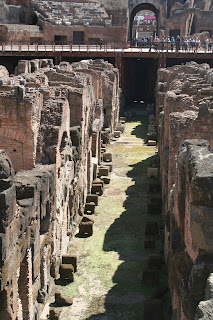A portion of the aqueduct that fed the Colosseum.
The Arch of Constantine
The Arch of Constantine is located next to the Colosseum.
The Colosseum was built in three layers. Two of the layers from a portion of the structure collapsed after earthquakes weakened the building.
The holes in the interior layers are left from the posts that connected the layers and have been removed.
The base of the columns from the outer layers are still located around the exterior of the Colosseum.
There were 76 public entrances were labeled with numbers at the top of the arch. The numbers indicated the entrance and section of the stadium where individuals were to sit based on their tickets. Tickets were made of wood or leather.
The vaulted ceiling of the interior between the outer and middle layers.
A partial floor was reconstructed to illustrate the flooring of the arena which was covered with wooden planks and sand.
Where the cross is located was once the platform for the emperor to view the spectacle of the arena. Behind that is the entrance reserved for the emperor.
The large group of people are standing in front of the entrance of the gladiators and the exit for the victorious gladiator at the end of the battle. The losing gladiator would exit from the opposite side and return to the training building of the gladiators.
Over the years, parts of the columns from the upper portions of the Colosseum have fallen and placed throughout the first level.
My view from the gladiator entrance. The loser's exit is across the arena below the center arch.
The substructure of the arena is a warren of smaller chambers that were used to hold prisoners and animals that would be fighting in the arena.
A remaining portion of the aqueduct outside of he Colosseum.
The Circus Maximus was a chariot race track built into the valley-like area within the city. There was no need for a large structure, because they built the seating within the hillsides. All that is remaining of the structure are some portions of the seating and the rectangular track.
A policeman taking a sip of water from a public fountain that has been in use for thousands of years. (The pipes have been updated!)
The Trevi Fountain
The Pantheon
The columns of the Pantheon
The center of the Pantheon has an opening that provides light throughout the day inside the main chamber.
The walls of the Pantheon are covered with multiple colors of marble from throughout the region.
Because of the open dome, the floors are not completely level and have filters that drain the water into a cistern below the structure.





































Never knew that had drains in the floor! Dee
ReplyDelete